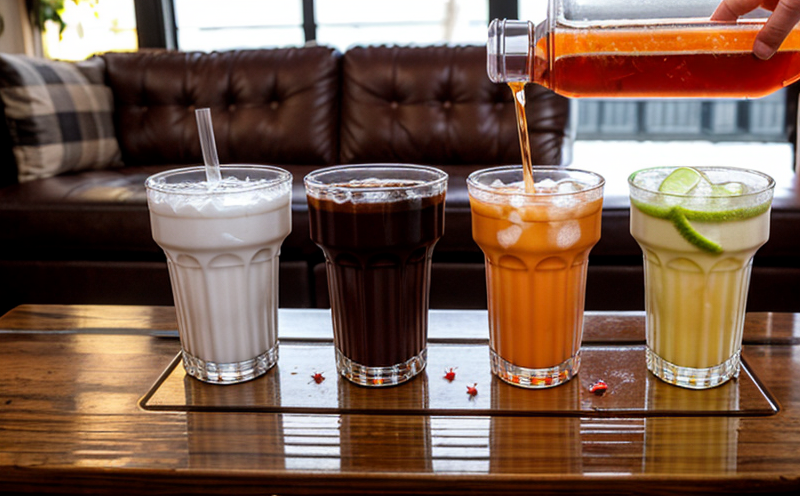ISO 5522 Sensory Evaluation of Fruit Juices
The ISO 5522 standard provides a robust framework for sensory evaluation of fruit juices, ensuring the quality and consistency of taste, aroma, color, and overall perception. This method is essential in the food & feed testing sector as it helps manufacturers to maintain product integrity and customer satisfaction.
Sensory evaluation, also known as flavor profiling, involves assessing a product's sensory attributes using human senses. In the case of fruit juices, this process evaluates how the juice tastes, smells, looks, and feels in the mouth. This standard is particularly important for manufacturers who need to ensure that their products meet specific taste profiles and consumer expectations.
ISO 5522 outlines a standardized approach to sensory evaluation, which includes defining the test conditions, selecting trained panelists, designing the test procedure, and analyzing the results. The process ensures that all involved parties are working under consistent guidelines, thereby enhancing the reliability of the evaluations.
The application of this standard is especially crucial for beverages as it helps in identifying potential quality issues early on. For instance, a deviation from expected taste or aroma can indicate contamination, improper storage conditions, or variations in ingredient composition. Early detection of such issues allows manufacturers to take corrective actions promptly, ensuring the consistency and safety of their products.
The ISO 5522 method is widely used across various sectors including food manufacturing, beverage production, and quality assurance departments. By adhering to this standard, companies can enhance their reputation for delivering high-quality products that meet or exceed customer expectations.
Applied Standards
| Standard | Description |
|---|---|
| ISO 5522:2018 | Sensory evaluation of food—General principles and procedures for sensory profiling. |
The standard covers various aspects such as the selection of panelists, preparation of test samples, administration of tests, scoring systems, and interpretation of results. It ensures that all participants in the sensory evaluation process are aware of best practices and standardized methods to achieve accurate and reliable outcomes.
For manufacturers, this method provides a structured approach to taste testing, which is critical for maintaining product quality and consistency. By following ISO 5522 guidelines, companies can ensure that their products meet the desired taste profiles and comply with regulatory requirements.
Why It Matters
The sensory evaluation of fruit juices according to ISO 5522 is not just a technical exercise but a crucial component in maintaining product quality and consumer satisfaction. Sensory attributes are what make beverages appealing, and any deviation from the expected taste or aroma can have significant implications for brand reputation and customer loyalty.
For instance, consumers expect fruit juices to have a distinct flavor profile that reflects the specific type of fruit used. Any inconsistency in this aspect can lead to dissatisfaction among customers. In addition, regulatory bodies worldwide are increasingly focusing on sensory attributes as part of their quality control measures. Compliance with standards such as ISO 5522 helps manufacturers demonstrate their commitment to product excellence and regulatory compliance.
Moreover, the method allows for continuous improvement in production processes. By regularly evaluating products using this standard, companies can identify areas where improvements are needed and implement changes accordingly. This proactive approach ensures that the final product consistently meets or exceeds expectations, thereby enhancing brand reputation and customer satisfaction.
The sensory evaluation process also plays a vital role in ensuring safety and compliance with local regulations. It helps manufacturers detect any potential issues early on, which can prevent costly recalls and damage to brand image. By adhering to ISO 5522 guidelines, companies demonstrate their dedication to maintaining high standards of product quality and consumer safety.
Why Choose This Test
- Consistency: Ensures that the taste and aroma of fruit juices are consistent across batches and production runs.
- Quality Assurance: Helps in identifying any issues early on, ensuring that only high-quality products reach the market.
- Customer Satisfaction: Maintains expected flavor profiles to ensure customer satisfaction and loyalty.
- Regulatory Compliance: Ensures compliance with international standards and local regulations.
- Continuous Improvement: Allows for continuous monitoring of products, leading to ongoing quality enhancements.
- Brand Reputation: Demonstrates a commitment to product excellence and consumer safety.
The sensory evaluation process is an essential tool in the food & feed testing sector. It provides a structured approach to taste testing that ensures consistent results across different batches of fruit juices. This, in turn, helps manufacturers maintain high standards of quality and customer satisfaction. By choosing this test, companies can ensure that their products meet or exceed expectations while also complying with regulatory requirements.





